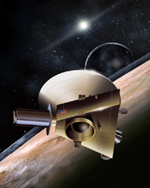
Image credit: NASA/JHUAPL/SwRI
The Solar Wind Around Pluto (SWAP) instrument aboard the New Horizons spacecraft is designed to measure the interactions of Pluto and Charon with the solar wind, the high-speed stream of charged particles flowing out from the sun. Understanding these interactions will expand researchers’ knowledge of the astrophysical processes affecting these bodies and that part of the solar system.
The space science community understands the extremes (called the bounding states) of solar wind interactions with planets, comets and other bodies, but no one knows what kind of interaction is present at Pluto. Comet Borrelly represents a strong interaction with the solar wind, while Venus represents a weak one.
“We expect solar wind interactions at Pluto to lie somewhere between the strong and weak extremes,” says SWAP Principal Investigator Dr. David J. McComas, a senior executive director at Southwest Research Institute? (SwRI?).
After taking measurements at Pluto, researchers plan to use the SWAP data to define basic parameters about the system. For example, once researchers know how such material comes off Pluto, they can then estimate the amount of Pluto’s atmosphere that escapes into space. This will reveal insights into the structure and destiny of the atmosphere itself.
SWAP would go on to take similar measurements at Charon and at least one Kuiper belt object; however, the team expects those interactions to be much weaker simply because the atmospheres of these objects are expected to be less extensive and not likely to emit much material.
Another of the many Pluto mysteries is where the interactions of the solar wind will occur around the planet, so science plans call for SWAP to take continuous measurements as it nears and passes Pluto.
“We know when and where to use some of the instruments to take an image or a measurement at Pluto,” says McComas. “Solar wind interactions, however, present quite a challenge because we’re trying to measure this invisible thing surrounding Pluto at an uncertain distance from it.”
“The science we expect SWAP to perform is impossible to accomplish without actually going to Pluto-Charon and directly sampling its environment. That capability is something that NASA pioneered and which, to this day, only the United States can do,” says Dr. Alan Stern, principal investigator of New Horizons and an executive director at SwRI.
The incredible distances of Pluto from the sun required that the SWAP team build the largest aperture instrument ever used to measure the solar wind. It allows SWAP to make measurements even when the solar wind is very tenuous. The instrument also combines a retarding potential analyzer (RPA) with an electrostatic analyzer (ESA) to enable extremely fine, accurate energy measurements of the solar wind.
“Should the interaction between Pluto and the solar wind turn out to be very small, the RPA and ESA combination will allow us to measure minute changes in solar wind speed,” says Scott Weidner, the SWAP instrument manager and an SwRI principal scientist.
The various instruments aboard New Horizons were designed and are being built independently, yet they are expected to work together to reveal significant new insights about Pluto, Charon and their Kuiper belt neighbors. SWAP measures low energy interactions, such as those caused by the solar wind. Its complement, the Pluto Energetic Particle Spectrometer Science Investigation, or PEPSSI, will look at higher energy particles, such as pickup ions. The top of SWAP’s energy range can measure some pickup ions, and PEPSSI picks up where SWAP leaves off to see the highest energy interactions.
The sun and its solar wind affect the entire solar system and should create interesting science opportunities for SWAP throughout its planned nine-year voyage to Pluto. SWAP will operate for more than a month each year and will sample heliospheric pickup ions?ions that originate in interstellar space and get ionized when they come near the sun. Other pickup ions come from material inside the solar system. Researchers have shown that even collisions between Kuiper belt objects result in tiny grains that drift toward the sun, evaporate and become ionized. The Cassini spacecraft, when it reaches Saturn this July, will allow researchers to observe
these so-called “outer source” pickup ions to 10 astronomical units (AU, the distance from the Earth to the sun), the region where pickup ions from the outer source are believed to begin.
“We’ll be out to 30 AU before New Horizons even reaches Pluto. While we’re targeting a Kuiper belt object, we could be anywhere from 30 to 50 AU, where the influence of heliospheric pickup ions becomes greater and greater in the solar wind,” says McComas. “On the journey out to Pluto, we’ll be able to validate or disprove the outer source theory, which is an exciting warm up to reaching Pluto itself.”
Original Source: SWRI News Release
